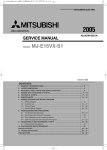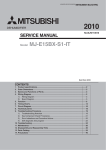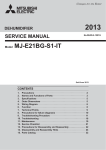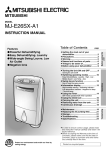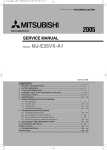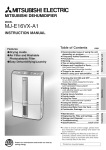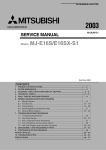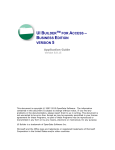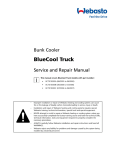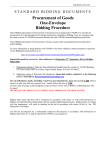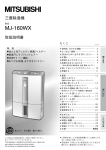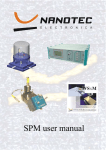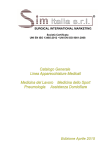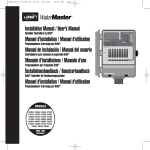Download Mitsubishi Electric MJ-E16VX-A1 Service manual
Transcript
MITSUBISHI ELECTRIC ADVANCED AND EVER ADVANCING 2005 DEHUMIDIFIER SERVICE MANUAL Model No.MJW-0502A MJ-E16V-S1 Sold from 2005 CONTENTS 1. 2. 3. 4. 5. 6. 7. PRODUCT SPECIFICATIONS........................................................................................ 2 OUTER DIMENSIONS .................................................................................................... 3 EXTERNAL VIEW, PARTS AND DISPLAY SECTION................................................... 3 NAMES AND FUNCTIONS OF PARTS....................................................................... 4 ~ 8 TECHNICAL POINTS................................................................................................... 9 ~ 11 MAINTENANCE ......................................................................................................... 12 ~ 13 WIRING DIAGRAM AND BLOCK DIAGRAM 7.1 Wiring Diagram....................................................................................................... 14 7.2 Function List ....................................................................................................... 14 ~ 16 7.3 Timing Charts ..................................................................................................... 17 ~ 19 7.4 General Block Diagram ...................................................................................... 20 ~ 21 8. TROUBLESHOOTING PROCEDURE 8.1 Troubleshooting flowchart ................................................................................. 22 ~ 23 8.2 Key Component Check Procedures ....................................................................... 24 8.3 Error Indications and Corrective Actions ............................................................... 24 8.4 Self-Test Program and Execution Procedure ........................................................ 25 9. DISASSEMBLY AND REASSEMBLY HINTS .......................................................... 26 ~ 28 9.1 Disassembly Procedures ....................................................................................... 26 10. CONTINUOUS WATER DRAINAGE ............................................................................. 29 PARTS CATALOG .......................................................................................................... 30 ~ 37 11. TROUBLESHOOTING ............................................................................................... 38 ~ 39 PRECAUTIONS ............................................................................................................... 40 ~ 42 1. Product specifications Model MJ-E16V-S1 Dehumidifying capacity 16.0 Laundry 41 Low 37 Single phase, 220-240V, 50Hz Power supply (phases,V,Hz) Power consumption (W) 275 Operating current (A) 1.3 Starting current (A) 5.5 Beige (C) Color tone 570 × 384 × 183 Dimensions (H × W × D mm) Weight (kg) 11.7 Coolant quantity (g) 120 Evaporator Slit fin Condenser Slit fin Thermal overcurrent relay XB460VTE Model 150 Output (W) Primary: 26.1 , subsidiary: 70.7 Winding resistance (Ω)(20°C) With temperature fuse Sirocco fan Type 16 Output (W) 4 Flow rate selection Flow rate (m3/min) 2.4 or 2.5 720 [740] 2.6 [2.7] Operating room temperature (reference) (°C) 2.4 or 2.5 675 - 700 [740] 2.4 - 2.5 [2.7] 700 2.5 2.4 or 2.6 Hot gas type Humidity control Built-in humidity sensor Tank full protection Lead switch (automatic) Tank capacity (liters) Auto-stopper tripped with about 4.0 liters of water Continuous drainage Commercial hose (inside diameter 15 mm) Operation modes 675 or 720 1 ~ 35 (°C) Defrosting method EASY DEHUMIDIFYING · LAUNDRY · LOW · LOW TEMP · DRYING INSIDE · AIR PURIFIER Timer Off timer (2h · 4h · 8h) Air cleaning performance Yes Plug socket rating 16A The operating noise levels indicated are typical values measured in our anechoic room. 2 675 or 700 Low 675 or 700 Laundry Speed (rpm) Easy Dehumidifying Blower Product performance Blower protection Drying Inside Compressor Compressor protection Air Purifier Operating noise levels(dB) (30°C room temperature, 80% relative humidity) (liters/day) Low Temp Electrical characteristics Performance Item * The brackets [ ] enclose values measured at a room temperature of about 15°C or lower. 2. Outer Dimensions 3. External View, Parts and Display Section Drain the water tank before use Installing your dehumidifier Refrain from opening doors/windows during operation Make sure to leave some space around the unit. <For use in close proximity to a wall> Stop the louvre in the vertical position. Blowing air at the wall may cause staining. Drying laundry indoors ¡Direct the louvres at the laundry. ¡Space laundry to improve airflow. At least 50 cm At least 20 cm At least 2 cm At least 20 cm At least 20 cm Use the dehumidifier in a small, enclosed room. Operating noise Place the unit on top of a mat. This reduces vibration and noise. It also prevents leaving depressions on carpets. Maintain room temperature above 16°C with an air conditioner ¡ Drying times will vary depending on the nature of the laundry and the room temperature. In low temperatures, drying takes about twice as long as normal. In low temperatures (10°C), drying takes about twice as long as when normal (20°C+). ¡ The airflow is strongest to the top right of the unit. 3 4. Names and Functions of Parts Front Control panel Air purifying filter Already installed at time of purchase Pre-filter Front panel Water tank Tank lid Floating element Front door The water tank may contain water residue at time of purchase. This is from final product testing at the factory and is not due to a defect. Back Handle Raise handle to transport. Louvre Side air intakes (left/right) Do not block. Sensor Do not cover. Continuous drainage outlet Power plug NOTE It is impossible to remove the back panel because the two spots shown are fastened with two special screws. If the unit malfunctions, contact your Mitsubishi dealer: 4 Control Panel ¡OFF Timer Lamp Set time lights. ¡OFF Timer button For setting the Timer. ¡Lamp Current mode lights. ¡Auto button Switches mode to AUTO. ¡Mode button ¡Power button Use this to switch the unit ON and OFF. ¡Drying inside lamp Flashes when drying inside in progress. ¡Drying For switching from one operating mode to another. inside button Activates/ deactivates drying inside. You can select from 5 operating modes. ¡AUTO ¡LOW ¡LAUNDRY ¡LOW TEMP ¡AIR PURIFIER COLD (COLD lamp) The lamp lights up if the room temperature drops below 15°C. Activating LOW TEMP mode is recommended. All modes include dehumidifier and air purifier functions. Air purifier only operation. The dehumidifier function is disabled. DEF (DEF lamp) Airflow (dehumidifying) will stop and the frost that has accumulated inside will be melted and dropped into the tank when the lamp is on. Please wait a moment as operation will resume in around 5 minutes. While in DEFROST mode, airflow (dehumidifying) will stop. The sounds coming from the unit will also change. DEFROST will start automatically when room temperature drops below 15°C (This may be as often as once every 40 minutes). FULL (TANK FULL lamp) The unit automatically shuts down and indicates with the lamp and sound that the water tank is full. Empty the water tank. ¡ Tank full lamp lights. (The unit beeps.) ¡ Airflow stops ¡ Lamp turns off • After removing the water and replacing the tank, the Tank full lamp will go off, and then the unit will automatically return to operation mode. • When the Tank full lamp is lit, no operation but ON/OFF is possible. 5 Modes AUTO When you want to dehumidify easily. LOW, LAUNDRY, LOW TEMP and AIR PURIFIER LOW mode is for when you want to leave the dehumidifier on, LAUNDRY mode is for when you want to dry laundry, LOW TEMP mode is for preventing condensation or when the room temperature is low and AIR PURIFIER mode is for when you want to use only the air purification function. Press ¡ AUTO lamp lights Changes with every press Press ¡ Selected mode lamp lights ¡LAUNDRY The unit operates intermittently controlling the airflow to remove the damp feeling in the air. (There is no need to set the humidity level.) When the room temperature is high, the blower operates to decrease the damp feeling. The dehumidifier operates at High regardless of the humidity level. 50 20 Room temperature is below 27°C - the unit automatically sets the humidity level according to the temperature. 27 30 Room temperature (°C) Room temperature is above 27°C - the unit lowers the humidity level to 50%, then activates the blower. The dehumidifier is reactivated when humidity rises to 60%. ¡LOW The dehumidifier operates at Low regardless of the humidity level. The unit operates continuously automatically controlling airflow according to room temperature. The airflow is strongest below 15°C. The use of LOW TEMP mode is recommended when the COLD lamp is lit. When the temperature is low, condensation may still form on windows exposed to the outside air even when LOW TEMP mode is operating. Information 60 ¡LOW TEMP ¡AIR PURIFIER The unit cleans the air by passing it through the pre-filter and air purifying filter. The dehumidifying function is disabled. ∞ The air passes through the pre-filter and air purifying filter in all modes, cleaning the air even if the air purifier lamp is not lit. ∞ Cigarette smoke and toxins found in smoke, such as carbon monoxide, cannot be removed with these filters. Information Humidity level (%) ¡AUTO ¡ When temperature/humidification lowers, dehumidification level lowers. 6 ¡ Drying inside The inside of the unit can be dried to suppress mildew growth on the cooler. On days the dehumidifier is used, drying inside is recommended. Automatic operation To activate drying inside after every use. Manual operation To activate drying inside by pressing a button. Press while the unit is off Press while the unit is on ¡Drying inside standby ¡Drying inside starts (Drying inside lamp lit) Drying inside lamp flashes. Power lamp turns off. Set the louvre upright. Drying inside starts when operation ends Drying inside mode When the unit is turned off or the OFF timer ends. ¡Drying inside ends ¡Drying inside starts The Drying inside lamp turns off. Drying inside lamp flashes. Power lamp turns off. Close the louvre. Set the louvre upright. To abort drying inside Drying inside mode ¡Drying inside ends The Drying inside lamp turns off. Press the drying inside button while the unit is performing internal cleaning (the drying inside lamp turns off) Close the louvre. <To deactivate automatic operation> The power button does not abort drying inside. (Normal operation begins.) Information Press the Drying inside button while the unit is on (the Drying inside lamp turns off) ∞ It is recommended that the louvre be set upright when using drying inside. (Closing the louvre may produce noise.) ∞ Connecting/disconnecting the power plug deactivates automatic operation. ∞ This function does not remove existing mildew. Also, aborting drying inside may cause the benefits to diminish. ∞ The moisture expelled from inside the unit may cause the humidity level of the room to rise. ∞ The air leaving the unit may appear white depending on the humidity or temperature of the room. ∞ The moisture expelled from inside the unit may smell due to odorants that were not caught by the filter dissolving in the water. ∞ The OFF timer cannot be set during drying inside. <Drying inside operation> This operation takes approximately one hour. However, when the room OFF Regular operation Dehumidifier Air purifier temperature is below 1°C, drying time is shortened to protect the compressor. Drying inside operation (approx. one hour.) Airflow Approx. 30min. Airflow stops; compressor Operating activates (operating sound) sounds Compressor operates according to room temperature Approx. 20min. Compressor stops Airflow Approx. 10min. Unit stops automatically 7 [OFF Timer Operation] [Removing Water from the Tank] The OFF timer can be set for each 2, 4, 8 hours. Set the timer when the power is switched on. The unit automatically shuts down and lights the Tank full lamp when the tank (approximately 4L) is full. Empty the tank. 1 4 1 2 3 3 Remove the water tank. 2 Open the louvre manually Switch the power on Open the front door. Grasp handle and slide out. Select operating mode Select desired operating mode 4 <Hold the tank this way> Set operating time No Display (Low mode) ¡ One press - 2 is displayed ¡ Each consecutive press displays the following setting (2, 4, 8) 2 Remove the tank lid, and empty. Floating element Do not remove or dismantle the float. Press ➝The OFF Timer is set Tank lid ¡ OFF Timer lamp indicates remaining time ¡ Power automatically turns off at set time If drying inside is set to activate automatically, drying inside activates. Pour the water out as shown. To cancel <When you want to turn the unit off> Press the Power button. (Power off) 3 Press Confirm that the lid is securely attached to the water tank, and push the tank in. Close the front door. <When you want to disable the Timer OFF mode, and continue operation> 8 ¡ If the lid is not properly closed, you may have problems removing the tank. ¡ If the tank is not installed correctly, the tank full light will come on, and the unit will not operate. Press ∞ Empty the water tank before operating. The unit stops and the Tank full lamp lights if the tank becomes full during operation. ∞ The OFF timer cannot be set while drying inside is operating. Note Information Hold down the button until the OFF Timer lamp goes out. The unit returns to Low mode. Reattach the tank lid and replace the water tank. Do not remove or dismantle the floating element in the tank. If it is removed, the unit cannot detect when the tank is full, and this could result in leakage. 5. Technical points 5.1 The technical points of the new products 1) Drying inside During dehumidification, moisture accumulates on the heat exchanger. If left, this can lead to mildew growth, which is circulated around the room with the air discharge. Drying inside starts automatically after operation, and dries any moisture inside the unit. 2) Powerful 16-litre/day dehumidifying The uncomfortable damp feeling caused by humidity is something that needs to be removed quickly. Mildew can grow and damage the home or clothing when closets, dressing rooms, shoe cabinets, and other spaces where humidity is prone to collect are not dehumidified. A single high-capacity unit is effective in dehumidifying and drying various locations throughout the home, quickly moving from one point to the next. 3) Room humidity and sensible temperature comfortably controlled The EASY DEHUMIDIFYING mode controls humidity according to room temperature. If the room temperature rises during dehumidification, use CIRCULATION mode (*1) to lower the sensible temperature. *1 The automatic dehumidification and blower modes operate alternately controlling the sensible temperature and humidity to a comfortable level (50%–60%). 9 5.2 Operation and Performance Working temperature Defrosting Dehumidification is possible with a room temperature of 1 – 35°C. If the room temperature exceeds 35°C, however, the temperature inside the unit will increase; therefore, the protective device may activate and halt operation in some cases. For this reason, the louvres should be aimed upward. • If the room temperature is lower than 1˚C, there is danger of the removed water freezing, making dehumidification impossible, so the fan will start operating. The unit may display during operation and stop air flow, followed by a change in the operating noise. The unit has stopped the airflow, and is melting internal frost into the water tank. The unit will resume automatically when the defrost operation completes. Wait for 3 minutes before dehumidifying Room temperature may rise 2-4°C during operation The dehumidifier will not operate for 3 minutes when the unit is turned on immediately after being turned off or plugged in. (In order to protect the compressor.) When dehumidifying begins, the operational noise increases. This is not a malfunction. The dehumidifier does not have a cooler function. Due to heat produced during operation, the room temperature may rise 2-4°C As a result, the unit may blow warm air, but this is not due to a malfunction. During winter, the air may not feel warm as the temperature is below body temperature. This operation will be performed automatically when the room temperature is approximately 15°C or lower. (When humidity is high, this will occur approximately once every 40 minutes for 5 – 10 minutes.) How does the dehumidifier work? If you pour cold water into a cup, the air around it becomes cold, causing water droplets to form on the surface of the cup. The dehumidifier takes advantage of this phenomenon to remove moisture from the air. 1 The unit draws air from the room, cools it with its cooling coil, causing the moisture to transform into water droplets. 2 The water droplets fall into the water tank. 3 The dehumidified air is reheated by the heating coil, and then discharged. The humidity of the room is thus reduced by repeating steps 1, 2, and 3. Dried (warm) air Cooling coil Moist air Compressor 10 Why CURRENT Water tank they differ are ent? The humidity reading on the unit may differ from a hygrometer in the same room Even in the same room, temperature and humidity levels may differ from place to place. If the hygrometer and the unit are in different parts of the room, the humidity levels are prone to differ. Moreover, humidity levels differ between places that have good and no airflow. Use the reading on the unit as an estimate. Re-heating coil <Cause> ● Inconsistencies in temperature and humidity ● Difference in location ● Difference in hygrometer precision 5.3 Coolant Circuit φ6.35 Compressor Coolant flow Dehumidifying Defrosting φ5 φ5 φ6.35 Tube temperature sensing thermistor Solenoid valve (closed when dehumidifying and open when defrosting) Heat exchanger (heat radiation) Blow Fan Capillary tube φ5.0 × φ4.0 Humidity sensor Heat exchanger (cooling) φ6.35 Intake Room temperature sensing thermistor φ6.35 φ6.35 Capillary tube φ2.0 × φ0.8 × 340 5.4 Performance curve When the temperature and humidity are low, the amount of water collected is decreased. In winter, because the temperature is lower than in summer, the effects of the dehumidifier decrease dramatically as shown in the graph below. Although less water collects in the tank, this is not a malfunction. * If the temperature is low, but the humidity is high due to snow or rain, operating the unit in LOW TEMP mode will yield better results than in LOW mode. Dehumidification capacity (L/day) Values for LOW when humidity is 80%. 16 14 12 10 8 6 4 2 0 5 10 15 20 25 30 Room temperature (°C) Summer (humidity) Winter (dampness) ¡ The values shown on the graph were measured at constant temperature and humidity and do not reflect values obtained in actual usage conditions. 11 6. Maintenance Maintenance Do not use detergents, cleaning agents for heat exchange equipment, abrasive powders, chemically treated dusters, gasoline, benzene, thinners or other solvents, as they can damage the unit or the water tank, which may result in leakage. Cleaning Water tank · Main unit Wipe with a soft cloth. Floating element Do not remove or dismantle. Do not remove the louvre front door. ¡ The unit draws in dust present in the air, and this may cause the tank to gradually become dirty. If the dirt does not come off easily, wash with cold or warm water, then wipe with a soft, dry cloth. ¡ Mildew may form in the tank unless kept clean. Once every two weeks Pre-filter 1 Debris clogging the pre-filter reduces the effectiveness of the dehumidifier. Clean once every 2 weeks. Remove the front panel and pre-filter. Front panel 3 Clean the pre-filter. Pre-filter Remove grit with vacuum cleaner. Hose with lukewarm water when excessively soiled. Dry well. 1 Remove holding the bottom. 2 Remove holding the tabs. 4 Honeycomb side Tabs (6) If the metal fin inside the main unit is slightly bent, the unit's performance is not affected. 2 Face the honeycomb side of the air purifying filter up and fit in the inside of the tabs of the pre-filter. Remove the air purifying filter. 5 Pre-filter Fit the air purifying filter. Attach the pre-filter and front panel. Air purifying filter The air purifying filter cannot be washed in water. Replace the air purifying filter when it becomes dirty. 12 1 Attach holding the tabs. 2 Hook the top edge to the top part of the unit and push the bottom in. Replacing the Air Purifying Filter The air purifying filter is disposable. Make sure to replace the filter when it becomes dirty. (The filter cannot be washed or reused.) When to replace it Replace the filter when it becomes dirty (brownish) with cigarette smoke, dust, etc. Generally, one filter should last about 6 months. (This will depend on usage conditions.) Replacing air purifying filter Storage After switching the unit off, leave for one day until any water inside has had time to run off, then carry out the following steps. 1 Performing drying inside to prevent mildew growth is recommended. 2 3 For maintenance procedures see xx 1 2 3 Attach air filter and front panel Bundle power cord. Remove the drainage water. Empty the water tank and wipe away any remaining drops of water. Remove the front panel and pre-filter Replace air-purifying filter Perform drying inside. 4 Parts sold separately Clean the pre-filter. Remove grit with vacuum cleaner. Air purifying filter for replacement ∞ Type: MJPR-SXFT ∞ Type code: 5C5 813 For these items contact your nearest Mitsubishi Electric dealer. 5 Store the unit. ¡ When you are sure that all parts of the unit are dry, cover it with a cloth to keep it from dust. ¡ Store the unit in an upright position in a place not exposed to direct sunlight. When disposing the unit Dispose according to the garbage regulations in your district. ¡ Air purifying filter Material: PP, PET ¡ Unit Do not disassemble. Dispose according to the garbage regulations in your district. 13 7. Wiring Diagram and Block Diagram CM R FM SV Solenoid valve Overload relay C Fan motor Compressor 7.1 Wiring Diagram S P5 P2 Blue P100 P3 Gray Run capacitor Sensors (Humidity and room temperature sensing) P200 Red Red Orange Orange Blue White Red Gray Yellow Black Blue Control board P10 P4 1°C (defrost)/12°C (end) Gray Blue Power plug Power supply board P1 Brown P11 White White P13 Gray Thermistor (Tube temperature sensing) Tank full switch Gray Safety Devices (1) Current fuse ....................Overcurrent flow caused by deterioration in electrical parts or other problems turns the power source to OFF. <Current setting: 2A> (2) Motor protector................The compressor stops operating if the room temperature exceeds 35°C. (Overload relay) The compressor will also shut down when malfunctions or other problems cause the current flow to exceed 5.3A. (3) Control circuitry ...............The room temperature thermister senses temperature below about 0°C, and shuts down the compressor. (4) Thermal fuse ...................When blower motor temperature exceeds 133°C due to blower locking or other malfunctions, blower operation shuts down. 7.2 Function List Air purifier Defrost Drying inside Low temp ON ON OFF ON OFF OFF - Hi ON ON OFF OFF OFF Mi OFF OFF - Blower Solenoid value OFF OFF OFF OFF Off timer Laundry ON ON/ OFF Mi/Lo/ OFF OFF Compressor Tank full Low Easy Dehumidifying Operation off Operation mode Dehumidifying operation Lo OFF OFF OFF ON Low Indicator Laundry Low temp One item is Easy dehumidifying Air purifier Off timer Tank full Defrost Low temperture Drying inside 14 = Lit. = Flashing. - = Varies by conditions. = Can light. = Not lit. <Operation Control> 1 Specifications shared at all operation modes The compressor and blower fan will operate for about 6 minutes after turning on the operation switch or activating the compressor, regardless of humidity or temperature levels. 2 Low, Low Temp, Air Purifier Compressor 14°C Fan temperature table 36°C 29°C 34°C 27°C 16°C Low ON Rank 1 Rank 1 Rank 2 Laundry ON Rank 3 Rank 4 Rank 4 Rank 5 Low Temp ON Rank 6 Rank 1 Rank 2 Rank 5 Air Purifier OFF Rank 1 Rank 1 Rank 1 Rank 1 Rank 5 3 Easy Dehumidifier 22°C Temperature 20°C 29°C Current humidity Temperature table 0 1 – Set humidity Set humidity 60% 50% Dehumidification Dehumidifier mode Dehumidifier mode Fan rank Compressor +5% +3% Fan rank Compressor Fan rank Compressor +1% –1% 36°C 27°C Rank 1 ON Rank 1 ON Rank 0 OFF Rank 1 ON Rank 1 ON Rank 0 OFF 34°C 2 3 60% Circulate 50% Dehumidifier mode 60% Circulate To Dehumidifier mode Rank 2 ON Rank 2 ON To Dehumidifier mode Rank 4 OFF To Circulate mode Rank 5 OFF 50% Dehumidifier mode Rank 5 ON Rank 5 ON To Circulate mode 1. Controls (a) Adjusts humidity according to room temperature for increased comfort. (b) CIRCULATION mode is activated when the temperature is high and the humidity is low. This mode keeps the compressor off. Target part Compressor Airflow fan Solenoid valve Louvre Operation ON/OFF Rank control OFF ON/OFF (c) Switches temperature table every 60 seconds to prevent the blower from turning on and off at the 3-minute restart for the coloured section in the chart above. (51% – 59%) (d) When the room temperature is above 29°C (temperature rising) or 27°C (temperature decreasing), CIRCULATE mode operates with the humidity below 50%. (e) The unit activates the dehumidifier when the humidity rises above 60%, and returns to CIRCULATE mode when the humidity drops below 50%. Set humidity 60% Circulate Dehumidifier mode Circulate Set humidity 50% set humidity 60% set humidity 50% set humidity 60% 60% 50% Humidity ON OFF Blower ON OFF Temperature ~20°C~ ~27°C~ Compressor Humidity 60% Set humidity 60% When 60% exceeded, lowers to below 50% Set humidity 50% 50% Compressor Compressor OFF OFF Fan rank 0 Fan rank 0 20°C CIRCULATE mode 27°C Room temperature 2. Easy DEHUMIDIFYING mode is disabled in the following cases. (a) The MODE button is used to activate the previously set mode (AIR PURIFIER, LOW, AUTO, LAUNDRY, LOW TEMP). (b) The DRYING INSIDE button is used to activate DRYING INSIDE mode. 15 4 Drying inside 1. Controls (a) Prevents the growth of mildew by drying the moisture accumulated on the heat exchanger when the dehumidifier is OFF. (b) Drying inside operation does not depend on having a full water level. (c) The following operations are performed during drying inside operation. Target part Compressor Airflow fan Solenoid valve Operation ON/OFF Rank control OFF 2. Start conditions for drying inside operations (a) Automatic drying inside mode - This mode starts when the Drying inside button is set to ON, and any of the following conditions are met. • The Power button is turned OFF. • The OFF timer time is reached. (b) Manual drying inside mode - This mode starts when the Drying inside button is operated while the following condition is met. • The Power button is turned OFF. 3. Operating details (a) The following indications are displayed during DRYING INSIDE operation • LED indicator: Only Drying inside lamp flashes, others off (b) Drying inside operates according to the following steps • Step 1: Moisture is allowed to drip from the heat exchanger. • Step 2: Moisture on the heat exchanger is dried with air. • Step 3: Moisture on the heat exchanger is dried with heat. • Step 4: The heat exchanger is cooled if the temperature rises too high. • Step 5: Internal humidity is discharged in Step 4. (c) Step 3 does not perform the tube temperature or room temperature check that accompanies a microprocessor reset, and jumps directly to Step 5. (d) Mechanisms operated in the above steps (* are deemed E2PROM data.) Step Fan Compressor Solenoid valve Conditions for moving to next step Step 1 Rank 1 OFF OFF Operates for 5 min. Step 2 Rank 1 OFF OFF Operates for *25 min. Step 3 Rank 0 ON ON Moves to Step 5 when tube temperature is above 45˚C * or unit operates for MAX 20 min. Step 4 Rank 0 OFF OFF Operates for 20 min including time for Step 3. * Step 5 Rank 1 OFF OFF Drying inside stops after operating for 10 min. 4. Conditions for drying inside operation to end (a) Upon completion of step 5 above. (b) The following buttons terminate drying inside operation (during steps 1 to 5 above) when pressed. • Power button • Drying inside button • ON timer button (c) The following operations are performed when drying inside ends. Target part Compressor Airflow fan Solenoid valve Louvre Operation OFF Rank 0 OFF Closed 5. Drying inside operation is not performed under the following conditions. (a) The power is ON. (b) The ON timer is operating. (c) An error is detected during self-diagnosis. 16 7.3. Timing Charts When room temperature is between 20 and 27 Easy dehumidifying/ Mode Power ON Operation switch Tank full light Easy dehumidifying ON OFF max 3 min. min 7 min. Lo Easy dehumidifying Low temp 3 sec. Tank full Power OFF Drain OFF OFF Hi Mi for 2 sec. at start-up. Mi LO 60% 50% Room temperature OFF Humidify Lo Lo 3 sec. ON SH Blower fan Increase in room temperature ON ON Float switch Tank full/ Power OFF Low temp Decrease in room temperature AUTO ON OFF Operation mode Compressor Mode button ON 16 14 17 18 Off timer Defrost Defrost count start Operation switch Defrost start Timer button OFF OFF ON OFF ON Compressor OFF ON Solenoid valve OFF ON Blower fan Tube temperature Off timer ON Off timer ON After 4 hr. 4 hr. OFF ON Timer lamp Off timer ON After 2 hr. After 1 hr. ON ON Mode lamp Defrost finish OFF 12 0 40 min. 2 hr. 2 hr. Cleaning inside (manual) Operation switch Operation mode lamp Cleaning inside switch Cleaning inside lamp Solenoid valve Blower fan Tube temperature Tube temperature Cleaning 45 inside complete Cleaning inside switch Operation OFF ON Start Cleaning inside ON OFF ON OFF ON OFF ON OFF 30 min. Compressor Cleaning inside (automatic) Tube temperature Cleaning 45 inside complete Cleaning inside switch ON ON max 20 min. 30 min. 10 min. 60 min. 60 min. OFF ON OFF ON OFF 45 45 max 20 min. 10 min. 19 7.4 General Block Diagram 20 21 8. Troubleshooting Procedure 8.1 Troubleshooting flowchart The unit does not operate Start Check AC power supply Abnormal Restore AC power supply Normal Blown Has the fuse blown out? Replace fuse Not blown Is the float switch turned on? OFF Mechanical check ON • Correct defects. • Replace the switch if defective. Control board connector check With the power plug removed from the receptacle, remove and insert each connector two to three times to improve its contact. Then, insert the power plug into the receptacle to make an operation check. Make sure that the flat cable and the connectors are inserted straight. Uncorrected Replace control board Dehumidifier doesn’t operate at all Step 1 Check operation Set mode to LOW. Step 2 Does the fan operate? YES NO Check connectors NO Are the resistor values of the fan motor no good? (See page 24) NO Replace board to 22 A Replace motor A Step 3 Does the compressor operate? (NO if stalled) NO *The compressor does not operate for 3 minutes after turning the power ON or OFF. (See page 10) Is there an overcurrent? (Surface is hot) Replace compressor NO Check connectors YES Is the compressor relay operating properly? Check board (open/bridge) Check resistor values for temperature sensor (See page 24) Replace sensor or repair open/bridge Is the continuity of the motor protector no good? (Normal: CLOSE; Malfunction: OPEN) Replace motor protector *Check when there is no current and the unit is at room temperature. Are the resistor values of the compressor no good? (See page 24) Replace compressor Replace board Step 4 Is the heat exchanger (evaporator) cold? NO * Check by operating for 30 minutes. Check the coolant circuit. (Leaks or blockages) *The part of the cooler near the tube temperature sensor should be at least 10˚C lower than room temperature when normal. YES Step 5 Are the power consumption and current normal? NO YES Step 6 YES Is the filter blocked? Clean filter NO Step 7 Is the operating environment low humidity or low temperature? YES NO Is dehumidification taking place? (Water drops are being collected) NO Dehumidification may not be possible in low humidity and low temperature environments. (See page 10) Recheck Steps 3 to 5 YES No problem * *If error indicators are lit, see Error Indications and Corrective Actions on page 24. If the customer complains that the unit won’t dehumidify, make the following checks before starting to repair the coolant circuit: 1 Clogged filter, or dust: ➞ Action: Clean. 2 Low-temperature, low-humidity operating environment: ➞ Action: See the explanation of the graph on page 11, or move the unit to a kitchen or bathroom and request verification of its performance. 3 Request checking whether the unit is in an automatically-stopping operation mode such as “EASY DEHUMIDIFYING”, etc. ➞ Action: Verify to dehumidify in “LOW” operation mode. (See pages 6 – 7.) 23 8.2 Key Component Check Procedures Component name Tub temperature sensing thermistor P11 Room temperature and humidity sensor board Testing procedure Detach the connector and measure the resistance using a multimeter (component temperature: 10°C to 30°C). Normal Abnormal Between P11 pins: 8.0kΩ to 20.8kΩ Open or shorted Detach the connector and measure the resistance using a multimeter (component temperature: 10°C to 30°C). Normal: 47 to 51kΩ (between P10 pins 3 and 4) Abnormal: Open or shorted With the connector detached, measure the resistance across the terminals using a multimeter (winding temperature: 10°C to 30°C). Abnormal Normal Compressor C-R side 25.0Ω ~ 27.1Ω C-S side 67.9Ω ~ 73.5Ω Open or shorted Measure the resistance between terminals using a multimeter (winding temperature: 10°C to 30°C). Solenoid valve coil Abnormal Normal Fan motor Yellow-Blue 258Ω ~ 280Ω Black-Blue 379Ω ~ 411Ω Open or shorted Measure the resistance between terminals using a multimeter (component temperature: 10°C to 30°C). Normal Abnormal 2.6kΩ ~ 2.9kΩ Open or shorted Measure the resistance across terminals with a multimeter. (Part temperature: approx 25°C) Stepping motor Normal Abnormal 342Ω ~ 418Ω Open or shorted Terminals 1-2 Terminals 1-3 Terminals 1-4 Terminals 1-5 8.3 Error Indications and Corrective Actions Indication (Timer display) All Mode lamps lit Error (failure) Frequency determination error Watchdog error RAM error 24 Corrective action Check power plug and 100V power supply (Try replacing main and power supply boards) Replace main board (Try replacing main and power supply boards) Replace main board All timer lamps lit Compressor Check blowing performance Check tube temperature thermistor Check compressor operating noise COLD LAMP flashing Disconnection or short circuit in room P.10, P.11 Connection check Check each thermistor or tube temperature thermistor 8.4 Self-Test Program and Execution Procedure (1) Deactivating 3-minute restart prevent lock ●Start: Press the MODE and AUTO buttons together 3 times when the power is off. Press the POWER button within 2 seconds. ●Functions: 1 Deactivates 3-minute restart prevention lock (immediate operation) 2 Fan: Fix at rank 6 (max. airflow) 3 Activates compressor 4 Operating mode: Low Temp 5 COLD lamp is lit. 6 When E2PROM error is detected, Full, drying inside, DEF lamp are lit. ●To end: Turn power off. The solenoid valve functions for 4 seconds. (2) LED sensor test Start...................... Press the MODE and AUTO buttons together 4 times when the power is off. Press the POWER button within 2 seconds. Mode selection ..... Use the AUTO button to change through the self test modes. Lights all LEDs Indicates Board type switch data and/or Micropr ocessor version Indicates EPROM2 data/version Tube temperature thermistor Room temperature thermistor LED display 2hr Sensor disconnection/ short circuit check 4hr LED display 8hr LOW TEMP LAUNDRY LOW Normal Disconnection Short circuit means lit LEDs Indicate current humidity in hexadecimal. First digit of humidity LED display Humidity detected by humidity monitor Example 2hr 4hr 8hr Second digit of humidity LED display EASY AIR PURIFIER LOW TEMP LAUNDRY DEHUMIDIFYING LOW 50% 77% Indicates error history/ error count 83% means lit 25 9. Disassembly and Reassembly Hints 9.1 Disassembly Procedures Picture 1 1. Remove the water tank (Pic. 1.) 2. Removing the front panel, and air filter assembly Catch Step 1) Push the front panel downward, and pull toward you (to release the catch on the bottom). Push up to remove. (Fig. 1) Step 2) Press the air filter assembly tab, pull the air filter toward you, and remove. (Fig. 2) Water tank Pre-filter Figure 1 Figure 2 Front panel Even if the metal fins on the inside of the unit become bent, this does not affect performance. 3. Removing the front casing assembly Step 1) Remove the water tank and front panel following the steps for sections 1 and 2 above. Step 2) Remove front casing set screws (two 4x14, four 4x12). (Pic. 2) Step 3) Pull the front casing assembly toward you so that it is away from the main unit. (Pic. 3) Step 4) Pull the power board box toward you, detach the catches on the box lid (one on each side), and remove the lid. (Pic. 4) Step 5) Remove connectors P100 and P101 (connectors for main board connection cable) from the power board. Disassemble the front casing assembly. (Pic. 5) Repairable parts Sets special screw (two 4x14) Picture 2 Setscrew (four 4x12) Control board Power board Tube temperature sensor Picture 3 Picture 4 Picture 5 P100 Catch 26 [To remove the control board] Step 1) Pull the front casing/switch operation part toward the outside, release the catch (protrusion) on the switch button on the main board cover side, and remove the main board cover assembly. (Pic. 6) Step 2) Release the main board catches (4 below, 1 on the right), and remove the main board. (Pics. 7, 8) Picture 6 Picture 8 Picture 7 Catch Picture 9 4. Removing the rear casing Step 1) Remove the water tank, front panel, and front casing assembly following the steps for sections 1 to 3 above. Step 2) Remove the rear casing setscrews (6). (Pic. 9) Step 3) Push the rear casing downward, and pull outward to detach the catches on the bottom. Lift the rear casing and raise the handle. Detach the catches that prevent the handle from coming loose, and remove the handle. (Pic. 10) Step 4) Pull the top part of the rear casing outward, and detach the catches (one on each side) that interlock the screw stop boss and the guide on the side of the fan assembly. (Pic. 10) Step 5) Lift the rear casing upward, and remove from under the louvre. (Pics. 11, 12) Step 6) Remove the louvre net. Repairable parts Fan Temperature/humidity sensor Solenoid valve Float switch Thermal over current switch Rear panel setscrew Picture 10 Handle Picture 12 Louvre Picture 11 Sensor Catches (one on each side) 27 5. To remove the fan assembly Picture 13 Step 1) Remove the water tank, front panel, air filter assembly, front casing assembly, main board, and rear casing following the steps for sections 1 to 4 above. Step 2) Remove the condenser and connectors (9) from the power board. Step 3) Remove the lead wires from both sides of the fan guide casing. Step 4 Remove the power board box assembly. (Pic. 13) Step 5) Detach the catches (one on each side) that interlock the fan assembly and the drain pan by leaning the top of the fan assembly toward the heat exchanger and pulling upward. Remove the fan assembly. (Pics. 14, 15) Repairable parts Box Valve Picture 14 Fan Fan motor Float switch Heat exchanger (radiator, refrigerator) [To remove the fan motor] Step 1) Remove the fan locknut and fan. (Pic. 15) Step 2) Remove the tape securing the fan motor lead wire, and separate the lead wire from the fan guide casing. (Pic. 16) Step 3) Remove the motor holding plate and setscrews (3). (Pic. 16) Step 4) Remove the holding plate, fan motor, and fan motor cushion. Catch Picture 15 Fan assembly Fan Net [To remove the float switch] Remove the float switch attached to the drain pan. (Pic. 17) Picture 16 Picture 17 Switch 6. To remove the drain pan assembly Motor holding plate setscrew Picture 18 Step 1) Remove the water tank, front panel, front casing assembly, rear panel, and fan assembly following the steps for sections 1 to 5 above. Step 2) Detach the catches interlocking the drain pan and the base, and remove the base while lifting the right side of the heat exchanger. (Pics. 18, 19) Catches for interlocking the drain pan and base Picture 19 Heat exchanger Base Repairable parts 28 Compressor 10. Continuous Water Drainage Necessary items If a drain is available, the unit can continuously drain excess water by attaching a commercially available hose (internal diameter 15mm). The unit can be operated for extensive periods without the need to empty the water tank. ¡Commercially available hose (ID 15mm) CAUTION Long enough to reach the drain. ¡Pincers Do not drain water continuously if there is a possibility that temperatures around the hose could drop below freezing point. How to set up the drainage hose Correctly installed 1 Water inside the hose may freeze and water may leak from the unit and damage surrounding objects. Incorrectly ¡ hose immersed in installed water ¡ hose raised to a level higher than the drainage outlet / The water will not drain. Remove the water tank. When draining water continuously or left unattended for long periods, inspect the unit once a fortnight. Foreign objects, etc. could clog the hose resulting in overheating and/or leakage. 4 Insert the hose into the drainage outlet on the back. 1 Feed the commercially available hose (ID 15 mm) into the drainage outlet while keeping the stopper pressed. Open the front door. 2 Grasp handle and pull out. Open the drainage outlet. Position of drainage outlet 2 Feed the hose into the drainage outlet. Hose 210mm Use cutters to cut the three fixing ribs of the continuous drainage port on the back of the main unit, then remove it carefully making sure that it does not fall inside the unit. 3 125mm 3 Confirm that the hose is securely attached and does not leak. Press drain stopper. Drain Stopper Note Push here 5 Replace the tank, and set the end of the hose in the drain. The unit cannot operate without returning the tank. ∞ Leave a minimum space of 20 cm behind the unit for attaching the hose. ∞ Confirm that the hose does not show signs of deterioration such as cracks and clogging. ∞ Inspect the hose every 2 weeks. Insects or dirt blocking the hose may cause leakage resulting in malfunctions. 29 Parts Catalog Model MJ-E16V-S1 Exploded View <Casing and Structure> magnifing picture 19 20 21 14 9 8 7 B C 6 13 5 12 11 17 18 10 A 16 2 30 3 1 4 22 15 Parts Catalog Model MJ-E16V-S1 Parts List <Casing and Structure> Notes: 1. Circled reference numbers indicate performance parts. 2. New parts and the parts that are used only with these models lack compatibility. 3. Those parts that are marked by and are of critical importance for sustaining safety and performance. Use specified parts atreplacement. 4. When ordering parts without part numbers, use the design number. The order may take a while to process. Exploded View Matching No. Part Name 1 2 3 4 5 6 7 8 9 10 11 12 13 14 15 16 17 18 19 20 21 22 TANK-S(X) COVER-TANK*100T LID-TANK-S(X) FLOAT*ASSY-100S(X) CASE-F*100VX-H ESC-SW*E16V PCA*MJ-E16V *M HOLDER-LAMP *100S FIXTURE PCA-M*100T PANEL-F*100V FILTER*ASSY-100V MJPR-SXFT CASE-R*100VX HANDLE*100/160V(X) BASE-100S(X) DRAINPAN*100S(X) SWITCH-LEVEL*160WX CUSHION-HEX-U*S(X) PACK-SRNSOR*S(X) PACK-SENSOR*S(X)-2 PACKING-SENSOR SPRING-S*100S A B C SCW-PL-TBFZR 4X12 SCW-MPFZR M4X14-TORX SCW-PL-TBFZR 4X12 Part No. Safety Pc/1 Part unit M22 B15 738 M22 B19 741 M22 B15 697 M22 B25 379 M22 B25 233H M22 C45 440 M22 C45 450M M22 B16 978 M22 B19 781 M22 B24 001 M22 B30 100 M48 5C5 813 M22 B25 232 M22 B25 063 M22 B15 290 M22 C44 700 M22 C44 501 M22 B15 218 M22 B15 222 M22 B15 223 M22 B25 224 M22 B15 128 1 1 1 1 1 1 1 1 1 1 1 1 1 1 1 1 1 2 1 1 1 1 — — — 4 2 7 Compatibility/Miscellaneous New New MJPR-SXFT (expendable item) *1. If the part is out of production, you may be required to use a common part. *2. Parts found installed in products may have a different part number from service parts. However, there should be no difference inperformance and can be installed. 31 Parts Catalog Model MJ-E16V-S1 Exploded View <Casing and Structure> 37 36 35 29 34 30 31 33 32 28 27 25 26 32 Parts Catalog Model MJ-E16V-S1 Parts List <Casing and Structure> Notes: 1. Circled reference numbers indicate performance parts. 2. New parts and the parts that are used only with these models lack compatibility. 3. Those parts that are marked by and are of critical importance for sustaining safety and performance. Use specified parts atreplacement. 4. When ordering parts without part numbers, use the design number. The order may take a while to process. Exploded View Matching No. Part Name 25 26 27 28 29 30 31 32 33 34 35 36 37 38 – – STOPPER-PLATE*100S(X) PACKING-RUB CUSHION-HEX-T CASING-100V(X) SPRING-LOUVER *N RUNCAPACITOR*E100 LEAD WIRE-R/C*140TX BOX-PCA*10/16V COVER-BOX*10/16V NET-S(X) LOUVER-V(X) SUPPORT-LOUVER INS-PLATE-MICA*10 LEAD WIRE S/M*VX NAME-PLATE*E16V-S1 I.B*E16V-S1 Part No. M22 B15 788 M22 J67 923 M22 B15 219 M22 B25 113 M22 J67 034 M22 C01 353 M22 B19 130 M22 B25 081 M22 B25 114 M22 C22 512 M22 B25 045 M22 B15 036 M22 B24 994 — M22 C45 450 M22 C45 791 Safety Pc/1 Part unit 1 1 2 1 1 1 1 1 1 1 1 1 1 1 1 1 Compatibility/Miscellaneous New New *1. If the part is out of production, you may be required to use a common part. *2. Parts found installed in products may have a different part number from service parts. However, there should be no difference inperformance and can be installed. 33 Parts Catalog Model MJ-E16V-S1 Exploded View <Electrical Parts> 1 A E 6 7 3 C 2 B D 9 34 4 8 5 e_mj_e16v_s1_sm(29_44)33j.qk 06.2.15 6:05 PM ページ 35 Parts Catalog Model MJ-E16V-S1 Parts List <Electrical Parts> Notes: 1. Circled reference numbers indicate performance parts. 2. New parts and the parts that are used only with these models lack compatibility. 3. Those parts that are marked by and are of critical importance for sustaining safety and performance. Use specified parts atreplacement. 4. When ordering parts without part numbers, use the design number. The order may take a while to process. Exploded View Matching No. Part Name 1 2 3 4 5 6 7 8 9 PCA*MJ-E23/16V *P SENSOR*HUM-100W(X) FAN-T(X)*ASSY HOLDING PLATE-M*NX-R MOTOR-E16VX LEAD WIRE-E16VX*ASSY M-PROTECTOR*LYDP98X RUBBER-MOTOR PLUG-CORD*E16S M22 C45 440P M22 B31 311 M22 B25 500 M22 C44 260 M22 C44 300 — M22 C44 502 M22 B13 511 M22 C29 395 1 1 1 1 1 1 1 3 1 A B C D E NUT-HFZR M6 SCW-PL-TBFZR 4X12 SCW-TPFZR 5X35M SPL WASHER-R SCW-MPBN M4X6 M22 B30 792 — — — — 1 3 3 3 1 Part No. Safety Pc/1 Part unit Compatibility/Miscellaneous New New *1. If the part is out of production, you may be required to use a common part. *2. Parts found installed in products may have a different part number from service parts. However, there should be no difference inperformance and can be installed. 35 Parts Catalog Model MJ-E16V-S1 Exploded View <Compressor Parts> 12 18 19 A 1 3 2 11 13 14 15 17 16 6 back 4 5 7 21 8 9 20 36 22 10 e_mj_e16v_s1_sm(29_44)33j.qk 06.2.15 6:13 PM ページ 37 Parts Catalog Model MJ-E16V-S1 Parts List <Compressor Parts> Notes: 1. Circled reference numbers indicate performance parts. 2. New parts and the parts that are used only with these models lack compatibility. 3. Those parts that are marked by and are of critical importance for sustaining safety and performance. Use specified parts atreplacement. 4. When ordering parts without part numbers, use the design number. The order may take a while to process. Exploded View Matching No. Part Name 1 2 3 4 5 6 7 8 9 10 11 12 13 14 15 16 17 18 19 20 21 22 S/COIL TAPE*ASSY-EVX SOLENOIDO VALVE-R TAPE THERMISTOR-EVA*W(X) COOLER*100T(X) CONDENSER*100W(X) CLIP TERMINALCOVER PACKING COMP*XB460VTE PIPE SV-CT*100S(X) PIPE CT*100S(X) CHARGE PIPE*100S(X) JOINT PIPE D-J*P(X) PIPE OUT EVA-100S(X) PIPE IN COOL*100S(X) PIPE COVER*C.T PIPE IN CON*100S(X) PIPE SUC*S(X)*ASSY PIPE COVER*COMP PIPE DIS*S(X) A SCRE SEMS M4X0.7X6 Part No. Safety Pc/1 Part unit M22 C44 629 M22 C50 629 — M22 C44 555 M22 B19 630 M22 B31 620 — M22 B15 018 M22 J16 923 M22 C13 820 — — — M22 B15 653 — — — — — M22 C29 645 M22 B15 221 M22 B15 650 1 1 1 1 1 1 1 1 1 1 1 1 1 1 1 1 1 1 1 1 1 1 — 1 Compatibility/Miscellaneous attached New XB460VTE E16SX-A1 *1. If the part is out of production, you may be required to use a common part. *2. Parts found installed in products may have a different part number from service parts. However, there should be no difference inperformance and can be installed. 37 11. Troubleshooting ¡ For the symptoms listed below, refer to the remedies listed right. Symptom Cause/Remedy The unit blows warm air ¡ Dehumidified air passes through heating coils causing it to warm (this unit is not a cooler). This is not a malfunction. Water does not collect in the water tank (minimal dehumidifying results) ¡ Check to see if the temperature/humidity is low. Low room temperature/humidity reduces dehumidifying effectiveness (in winter, the air is cooler reducing the amount of water collected). This is not a malfunction. The unit does not turn on (no air comes out) The unit keeps turning off ¡ Check to see if the power cord is correctly plugged. ➝ Plug the power cord properly into the power socket. ¡ Check to see if anything is blocking the air intake or outlet. ➝ Remove the obstruction. ¡ Check to see if the pre-filter is clogged. ➝ Clean according to the maintenance procedures. ¡ Check to see if the unit is in AUTO. The unit is automatically controlling the dehumidifier, fan, and standby times. Lights Indicates 38 ¡ Check to see if the water tank is full. ➝ Empty the water tank and return it to its original position. ¡ Check to see if the water tank is inserted properly. ➝ Adjust the position of the water tank. ¡ Check to see if the unit is in defrosting mode. The unit activates defrosting mode when the room temperature drops below 15°C. The dehumidifier and blower functions stop during defrosting. The unit continues to operate even though it is turned off ¡ Is the unit set to drying inside mode? This function activates automatically after the unit finishes operating. The humidity level does not reach the level set ¡ Check to see if the room is not too large. ¡ Check to see if the exits to the room are open. ➝ Refrain from opening doors/windows during operation. ¡ Check to see if steam producing appliances such as kerosene heaters are on in the vicinity. The water tank contains liquid or white water residue ¡ The residue is from final product testing at the factory. It is not a result of a malfunction. There is black residue on the inside of the water tank and lid ¡ The residue is from debris in the air. ➝ Clean according to the maintenance procedures. Symptom The unit makes noises Cause/Remedy The operating noise is loud/reverberates ¡ Check to see if the unit is on a slope or uneven surface. ➝ Move to a sturdy even surface. ¡ Check to see if the pre-filter is clogged. → Clean according to the maintenance procedures. ¡ Operating the unit in small rooms or in tight spaces sometimes causes the sound to reverberate. ➝ Place a mat underneath the unit. The operating sound suddenly increases in volume ¡ The sound increases when the compressor activates (3 minutes after turning on the unit or during One-touch dehumidifier and Automatic modes). The wind sound changes in volume ¡ The volume of the sound differs depending on the angle of the louver. The unit produces a simmering sound ¡ This is the sound of the refrigerant. The sound can be heard while the refrigerant stabilizes after the unit turns on, changes modes, or stops. The unit produces a buzz that sounds intermittently (or the compressor does not activate) ¡ This is the sound of the compressor. In modes that monitor the humidity level or during drying inside the compressor operates intermittently causing the sound to be heard occasionally. The compressor does not activate after turning the unit off, or for 3 minutes after plugging the unit into a power socket. (This is to protect the compressor from damage.) When first used The unit produces an odour During drying inside ¡ The heat converter heats rapidly causing a brief odour. This is not a malfunction. ¡ The moisture expelled from inside the unit may smell due to odorants that were not caught by the air purifying filter dissolving in the water. This is not a malfunction. ¡ Error message Digital display All the Mode lamps are lit (LOW, LAUNDRY, LOW TEMP and AIR PURIFIER) All the Timer lamps are lit lamp flashes Cause/Remedy ¡ Check to see if the power cord is plugged into the power socket properly. ➝ Plug the power cord into the power socket properly. ¡ Check to see if anything is blocking the air outlet. ➝ Remove the obstruction, and plug the power cord into the power socket again. ¡ Check to see if the pre-filter is clogged. ➝ Clean according to the maintenance procedures. ¡ Malfunction ➝ Take note of the error message, unplug the power cord, and seek service assistance using the number on the next page. ¡ If the symptoms persist even after following the prescribed remedies, or the error message does not disappear, unplug the power cord, and seek service assistance using the number on the next page. 39 Precautions The following diagrams indicate circumstances where danger can result from mishandling the unit. WARNING Mishandling may result in fatal or serious injuries. CAUTION Mishandling may result in injuries or damage to your home or property, etc. Meanings of the graphic symbols used in this manual and on the unit are explained below. Always Do not Forbidden follow the disassemble instructions Keep away from fire Do not subject to water WARNING Do not start/stop the unit by plugging/unplugging the power cord. Do not put the unit near heatgenerating devices (such as stoves, fan heaters, etc.). This may result in fire and/or electric shock. Do not use extension cords or multiple head adapters. This may result in fire, electric shock or malfunctions. Do not damage or modify the power cord or plug. Do not modify, bundle, twist, bend or heat the power cord. Do not place under objects or use with the end close to the plug bent. The plastic parts may melt causing fire. Wipe dust off the power plug and insert the plug firmly. If the plug is not fully inserted into the socket, dust may gather on the connectors which may cause fire and/or electric shock. Use 220-240V AC power sockets. The cord may be damaged resulting in fire or electric shock. (Keep pets from biting the cord.) Do not put your fingers or any long object, into the air intake/outlet. The internal fan rotates at high speeds, and such actions may result in injury or malfunctions. 40 Connecting to power sockets other than 220240V AC may result in fire and/or electric shock. Remove water that has collected in the tank. Accidentally drinking the water or using it for other purposes may cause illness and/or unforeseen accidents. Do not attempt to repair, disassemble, or modify the unit. Should abnormal symptoms occur (a burning smell, etc.), switch off the unit and unplug it from the socket. This may result in fire and/or electric shock. See the last page for service contact details. Continuing to operate the unit may result in fire, electric shock, or malfunctions. See the last page for service contact details. CAUTION Do not cover the front or side air intakes or the air outlet with cloth, curtain, etc. This results in poor ventilation and may cause heat generation/fire. Do not stand on, sit on or lean against the unit. The unit may tip over causing injury. Do not drain water continuously if there is a possibility that temperature around the hose could drop to freezing point. Water inside the hose may freeze and prevent the water in the tank from flowing out. The water may leak from the unit and damage surrounding objects. Do not use the unit in places that may be subject to oil or flammable gas leakage. Such a leak around the unit may cause combustion and fire. Do not put vases or any other objects filled with water on the unit. Water may leak into the unit adversely affecting electric insulation and cause electric shock and/or fire by short-circuiting. Do not use the unit where it may be exposed to direct sunlight or other weather conditions. (This unit is for indoor use only.) This may cause overheating, electric shock and/or fire caused by an electric leak. Do not use the unit in narrow, enclosed places such as inside closets, between pieces of furniture, etc. Do not remove the Styrofoam from the floating element. The floating element will not be able to detect a full tank resulting in water leakage, which may damage surrounding objects or cause electric shock and/or an electric leak. Do not wash the unit with water. Do not use the unit where it is likely to come in contact with water. Exposure to water may result in fire or electric shock caused by an electric leak . Do not point air-flow from the unit directly at the body. This results in poor ventilation and may cause heat generation and/or fire. If air-flow is directed at the body for long periods, it may harm one’s physical condition and lead to dehydration. Do not use combustion appliances in the path of the air outlet. Install the unit in a location where the floor is flat and stable. This may cause incomplete combustion in the appliance. If the unit falls over, the water collected in the water tank may leak damaging surrounding objects and in turn result in fire or electric shock caused by an electrical leak. Do not use the unit in places where chemicals are used (such as hospitals, factories, laboratories or beauty salons). Grasp the plug and remove from the power socket. Chemicals and solvents evaporated in the air may harm the unit and cause water in the tank to leak, resulting in damage to property. When removing the plug from the power socket, do not pull on it diagonally or by the cord as this may cause the projections/wiring to be damaged resulting in a short circuit, electric shock or fire. Do not use the unit for special purposes, such as preservation of food, art or scientific works. This may negatively affect the quality of the items stored. Before moving the unit always switch it off, unplug it and remove water from the water tank. Moving the unit with water in its tank may cause the water to leak and damage the surrounding objects and in turn result in electric shock and/or an electric leak. 41 Precautions (cont.) CAUTION After emptying the tank, transport the unit by grasping the handle firmly. Losing your footing while carrying the unit may cause personal injury or damage to the floor. When using the continuous drainage outlet, make sure to position the hose so that the water drains without obstruction. The water in the tank may leak and damage surrounding objects. When draining water continuously or left unattended for long periods, inspect the unit every two weeks. Do not allow debris to clog the filter/hose as this may cause overheating/leakage. Use the unit with caution in rooms where the walls, furniture and art work are vulnerable to dry air, as it may cause cracks and warping. Switch the unit off and unplug from the power source when cleaning it. When the unit is on, the internal fan rotates at high speeds and may cause injury. Unplug the unit from the power source when not using the unit for an extended period of time. Otherwise it may cause fire and/or electric shock caused by an electric leak. 42 Warning ● Keep the unit always in an upright position. Inclining the unit may cause water in the tank to leak into the unit, resulting in malfunction. Should this happen contact service number on the last page for advice. ● Damage to the dehumidifier caused by atmospheric conditions (ie. Salt or Sulphur) will not be covered under warranty. ● Do not carry the unit horizontally. This may result in malfunctions. Such malfunctions are NOT covered under warranty. Packaging diagram 43 Issued in 2005.07 Printed in Japan












































